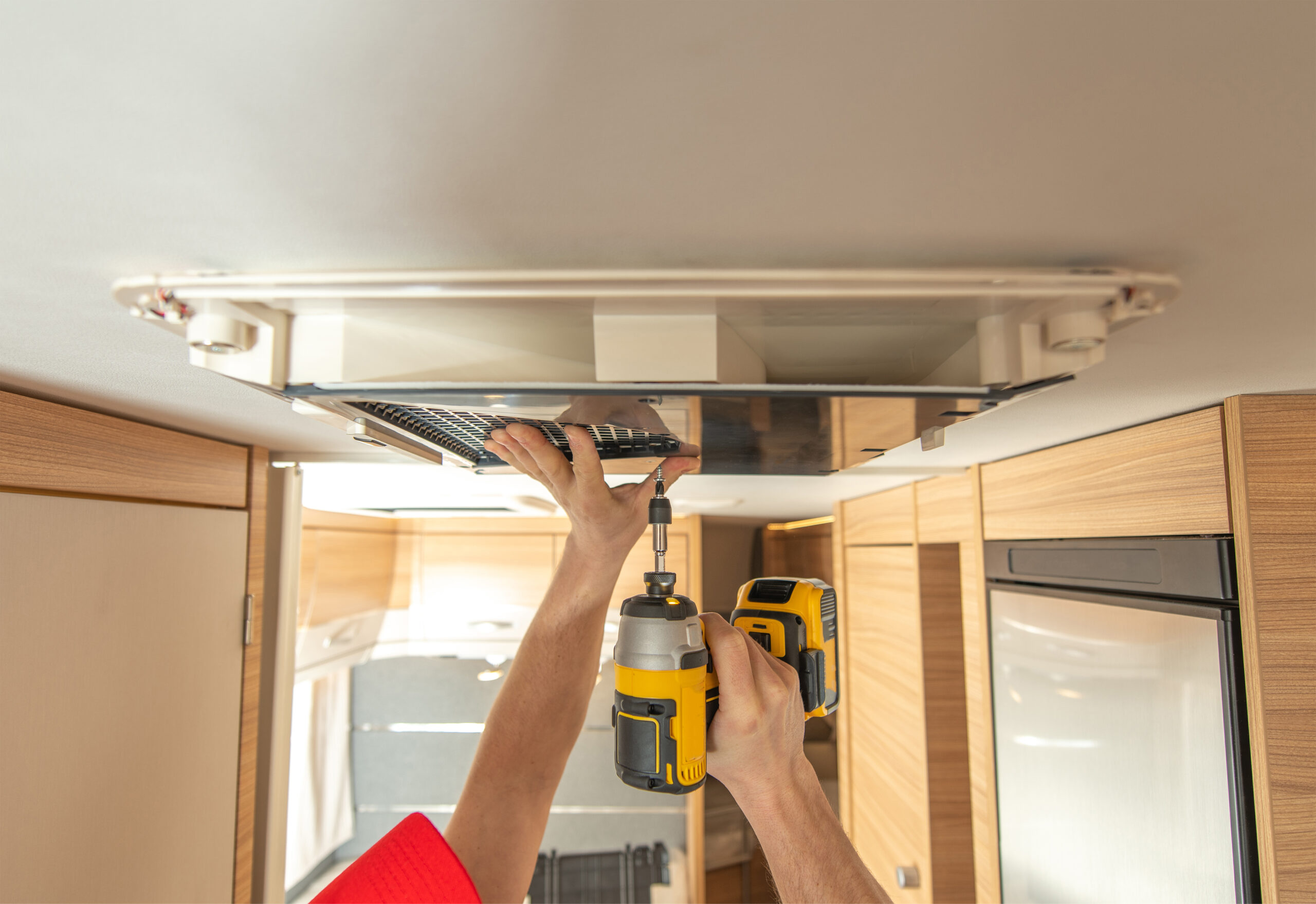Every RV needs a good set of furniture. These are the places where you will sleep, eat, and relax, so they need to be comfortable. Unfortunately, some items become stained or worn down over time. In other cases, the existing fabric might not match with your decorating aesthetic. Whatever the problem may be, reupholstering RV furniture could be the solution.
Reupholstering is a process where you replace the outer layer of fabric and sometimes the padding beneath. Although you can hire a professional to do this for you, many RVers have found success with a DIY approach. It all depends on your budget and skill set.
So if your RV furniture is in need of an update, try reupholstering a few pieces instead of investing in a brand-new replacement. A bit of fabric and craftiness can go a long way! Read on to learn about the process for reupholstering RV furniture.
How to Reupholster RV Furniture
Before we begin, remember that reupholstering RV furniture is a highly individualized process. Each piece is different and requires a separate assembly process. The process below is not meant to be a one-size-fits-all guide. However, it can serve as a starting point for how to perform this task.
1. Remove/Disassemble Each Furniture Piece
To begin, identify which pieces you’ll want to reupholster. Clear the area around each item and pull it away from the wall/floor if possible. Next, disassemble the various parts and lay them out so you can get a better idea of what you’re looking at. This might include cushions, padded arms, backrests, etc.
2. Take Photos of the Existing Piece
Next, take photos of each piece of the puzzle! It can get confusing once you start to strip everything down and replace various parts, so you’ll want a reference to refer to. You can also get a look at how/where the existing fabric is held in place so you can replicate it later on.
3. Examine the Frame Material
Before you move any further, take a closer look at the overall composition of the furniture. A deciding factor is whether the frame is made out of wood or metal. If it’s wood, you should have a fairly easy time removing staples, nails, etc.
Metal frames are a different case, and you may need special tools and materials to properly adhere to them. In addition, you should take a moment to test the frame’s strength during this stage. Any rot, breaks, or weak areas should be addressed now.
4. Choose a New Fabric
If you feel confident about moving forward, it’s time to choose a new fabric for the upholstery. You have a wide range of options here, so feel free to get creative! Choose any colors or patterns that you enjoy. Just make sure that your chosen material will work well as a furniture cover.
You may want to choose something that will resist stains and be easy to clean. Sturdy fabrics are also preferable so you don’t get rips or frayed edges. Synthetic microfiber blends are usually the best, but you can also use strong cotton weaves as well.
5. Gather Tools
Now it’s time to get your crafting tools together! These items will help you remove the existing fabric, shape your new design, and reapply it to the frame. The list below is a general list of necessities, but you may need additional specialty tools.
- Sewing machine
- Strong pins
- Scissors
- Hammer
- Pliers
- Staple gun
- Upholstery zippers
- Furniture foam
- Masking tape and marker
6. Remove Original Fabric Cover
Next, it’s time to remove the original fabric that’s covering the furniture. There should be seams or exposed areas on the back/bottom. If the furniture has a wooden frame, the fabric is usually secured by a series of staples. Use pliers to remove these, then pull the rest of the fabric away.
7. Inspect the Base Structure
Before you begin working on the new cover, take a moment to inspect the underlying layers of your furniture. There may be other pieces that need to be tweaked or replaced. Look for damaged foam, cracked support structures, misaligned springs, etc. If anything is out of place, pause the work so you can find/order replacement parts.
8. Replace Foam Layers (if necessary)
Next, focus your attention on the foam. Most furniture pieces have a few layers of foam, and they can become worn down over time. If there are any sections that are misshapen or stained, you can choose to replace them. Remove the old foam and cut new sections to fill the gap. This step can cause complications, so only do it if there’s a serious problem under the surface.
9. Cut/Sew Your Fabric to Size and Pull It Over the Furniture Pieces
Now, it’s finally time to start working on the new fabric cover! You can use the old cover as a guide for measurements as you go. Cut your chosen fabric to size and start stretching and sewing it to fit the new furniture. This step will require some sewing expertise, so be sure to use a high-quality machine that’s tough enough to sew thick fabric.
10. Secure the New Cover in Place with Staples, Ties, Etc.
Once you have the new cover, pull it into place and secure it with staples, metal loops, ties, and any other fasteners of your choice. The fit should be snug but not overly tight, so it won’t rip when weight is placed on it.
Replacing vs. Reupholstering RV Furniture
Reupholstering RV furniture can be a lot of work, and sometimes, the finished product doesn’t look as good as the original. Because of this, many people wonder if it’s better to buy entirely new furniture rather than try to fix the old stuff.
This is a personal choice! Both avenues have their own pros and cons, so you should explore all the possibilities before moving forward.
Replacing RV Furniture
For starters, replacing RV furniture can be quite expensive. Each piece needs to be custom-ordered or built because only certain pieces will fit the space. In many cases, replacing the furniture is at least twice as expensive as reupholstering. You’ll also have a limited selection of styles and fabrics to choose from.
However, replacements can be useful if there are deep structural problems with the pieces. If the springs or frame are broken, reupholstering won’t help much. You can also invest in high-quality furniture that’s better than the standard items the RV came with.
Reupholstering RV Furniture
One of the main perks of reupholstering is that it’s cheaper! You can get a fresh look for your furniture without spending a fortune on new items. You have the ability to shop around for deals on fabric, foam, and other supplies as well. In addition, you have a wide range of design freedom, so you can choose fun fabrics and materials.
Unfortunately, reupholstering can be a tricky process. If you’re not a professional, you may not be able to work with pieces that have metal frames. In addition, a new cover won’t fix underlying issues like damaged frames or foam layers.
Regardless of the approach you pick, try calling local stores for help. They may offer discounted rates for furniture replacements or upholstery jobs.
You can also go for a low-effort solution by using exterior furniture covers for extra protection and style. These just slip on over the existing surface. They may not look quite as professional, but they can still work just fine for a family RV.
Conclusion
Reupholstering RV furniture is not only a practical choice but also a creative journey. By following the steps outlined, you can give your RV a fresh and personalized look. And if you’ve embarked on this DIY adventure, don’t hesitate to share your tips and experiences in the comments below. Your insights could be invaluable to fellow RV enthusiasts looking to breathe new life into their mobile havens.
Related Articles:




We have an older **J-sofa** that the fabric gave up the ghost on. At some point we will replace the fabric, but for now we used a foam mattress topper & a futon cover from Amazon. This is slightly stretchy and works perfectly. We use a pool noodle cut lengthwise to tuck in the fold between the back & seat.
A project for this winter is re-doing a wooden chair that came with the RV, to use at the dining counter (we don’t have a booth set up & never did!). I am not able to remove the fabric on the road, so I am just going to use fabric glue to cover the old shattered fabric for now!!
Ikea is a good source for many things RV, we just replaced an older LR chair that had seen better days, with a smaller wood framed arm chair that is more comfortable, fits the space better, and because it doesn’t flex like the old one we can slide a container under there.